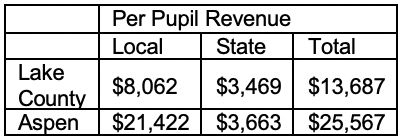FOR IMMEDIATE RELEASE
August 27, 2019
Contact: Cinamon Watson
303-949-7264
New study identifies trends in spending over the last decade, examines how teachers are paid and highlights the differences in funding across the state.
Denver, CO – In honor of the back-to-school season, this week Common Sense Policy Roundtable released “Dollars and Data: A Look at K-12 Education Funding in Colorado.” The study, authored by CSPR Education Fellow, Dr. Brenda Bausch Dickhoner and CSPR Director of Policy and Research Chris Brown provides an in-depth analysis of K-12 public education funding.
“Colorado is no stranger to the education funding debate,” said Dickhoner. “However, what is often missing from the discussion is a common understanding of how we fund public education in Colorado. This study provides baseline data and analysis to ground these important conversations in facts.”
According to CSPR President & CEO Kristin Strohm education is one of the most important issues CSPR addresses, “Without a quality education, opportunity is stifled, employers can’t hire an adequate workforce and our economy suffers. Unfortunately, in communities across Colorado, public schools are failing to provide the kind of quality education that prepares students to be productive members of the workforce.”
Strohm pointed to a statistic in the study as an example, thirty-five percent of Colorado’s high school students who graduated in 2017 and immediately enrolled in college were not prepared for college-level coursework and required developmental education.
In 2018, CSPR teamed with Colorado Succeeds to ask the question, “what is our education system was number 1?” Some point to a lack of funding as the obstacle to reaching the number one ranking as evidenced by multiple efforts at the ballot box to raise education dollars by increasing Colorado’s incomes taxes. There has also been an increased focus on teacher pay that has included numerous rallies at the State Capitol and a week-long teacher strike at Denver Public Schools earlier this year.
Is more money the answer? Are higher teacher salaries the answer? “We hope this study fills a significant gap in the debate on public education,” said Dickhoner. “By providing a clear picture of the facts, we have set the stage for an honest conversation about how we as a state can improve our education system.”
Key findings of the study include:
- Funding for K-12 education is at an all-time high for Colorado. K-12 education funding has been steadily increasing since 2013 when the state’s economy began rebounding from the Great Recession It is now at the highest level it has been at in the state’s history with total program funding at $8,480 per student.
- Structural flaws in the K-12 education funding system create inequities for local taxpayers and schools through both the collection and distribution of revenues. There is significant variation in the proportional amount taxpayers are contributing to public education through property taxes.
 In some instances, wealthy localities such as Aspen School District are receiving more state dollars than poorer school districts, such as its neighbor, Lake County, even after Lake County receives extra funding for at-risk students.
In some instances, wealthy localities such as Aspen School District are receiving more state dollars than poorer school districts, such as its neighbor, Lake County, even after Lake County receives extra funding for at-risk students. - Downward trend in the share of dollars going to instructional staff. From 2007 to 2017, the share of spending allocated to instructional salaries declined 3.5 percentage points. At the same time, benefits spending increased by 1.5 percentage points, largely due to the doubling of annual PERA payments needed to cover the growing unfunded liability. Spending on administrative functions, student support services, and operations increased as a share during the study’s time period as well.
- Teacher salaries vary dramatically around the state and within the Metro Denver region. The average salary for the Metro region in 2017 was $56,621, for example, which is 39 percent greater than the Southeast region’s average salary of $38,157.
- Teacher turnover is low in comparison to other jobs. The average turnover rate for Colorado employees in all other industries is nearly three times the turnover rate for teachers—48 percent compared to 17 percent, respectively. Only 2.3 percent of teachers responding to a statewide survey in 2017 stated they planned to leave the field of education that year.
Read the full study here.
###
Common Sense Policy Roundtable, Colorado Concern, Colorado Association of REALTORS®, Colorado CSPR is a non-profit free-enterprise think tank dedicated to the protection and promotion of Colorado’s economy, our mission is to research and promote common-sense solutions for the most pressing public policy issues facing Colorado. Learn more.

